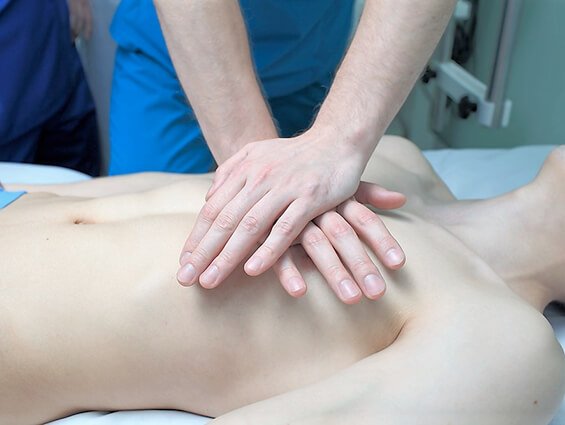A Hands-On Approach to Saving Lives

It’s something no parent or family wants to face — the sudden death of a child. While it is rare, sudden cardiac arrest is the leading cause of death in young athletes, most often occurring during athletic training or competition.
There are more than 356,000 out-of-hospital cardiac arrests each year in the U.S., about 7,000 of those are children younger than 18. Most sudden cardiac deaths are caused by abnormal heart rhythms.
“Sudden death among children and young adults is quite rare, however when it happens, it affects the whole family and the whole community,” says Dr. Jeffrey Orcutt, a pediatric cardiologist with OSF HealthCare Children’s Hospital of Illinois in Peoria. “It is hard to tell who the victim of that is going to be. Frequently these children are normal until the point when it happens, so the best defense that we know of is preparedness for when something were to occur, and the highest chance for survival of one of these events is early initiation of CPR.”
Orcutt says there’s no full-proof way to screen or determine if a child could be susceptible to sudden cardiac death, so regular check-ups with your child’s pediatrician, including a complete family history, are important. A family history of unexpected, unexplained sudden death in a young person, or fainting episodes or seizure during exercise, need to be documented.
The sad fact is survival of an out-of-hospital cardiac arrest to hospital discharge for a child is less than 11 percent, according to the American Heart Association.
That’s why Orcutt says the most important thing for everyone is to be prepared if sudden cardiac arrest occurs, and that means knowing CPR.
“Children as young as middle school age can learn to give effective chest compressions to adults, he says. “It’s something that takes very little practice and people can reasonably learn how to do high-quality CPR in an afternoon. Several years ago the guidelines were changed so that observer CPR is chest compressions only and no longer is it recommended for laypeople to do mouth-to-mouth resuscitation.
“We know the CPR saves lives, so that is a huge push for our community in pediatric cardiology is to try and get everyone to learn how to do CPR and be willing to call 9-1-1, push on the chest, and get an AED (automated external defibrillator). Those things really do save lives.”
Story Credit: https://advantagenews.com/news/a-hands-on-approach-to-saving-lives/
Since you’re here, we have a small favor to ask. Requests from schools and districts for our screening services are growing, which means that the need for funds to cover the cost of those services is also growing. We want to make our services available to those who request it and beyond, so you can see why we need your help. Safebeat heart screenings take a lot of time, money, and hard work to produce but we do it because we understand the value of a child's life, PRICELESS!
If everyone who reads this likes it and helps fund it, our future would be more secure. For as little as $1, you can support Safebeat and it only takes a minute. Make a contribution. -The SafeBeat Team


